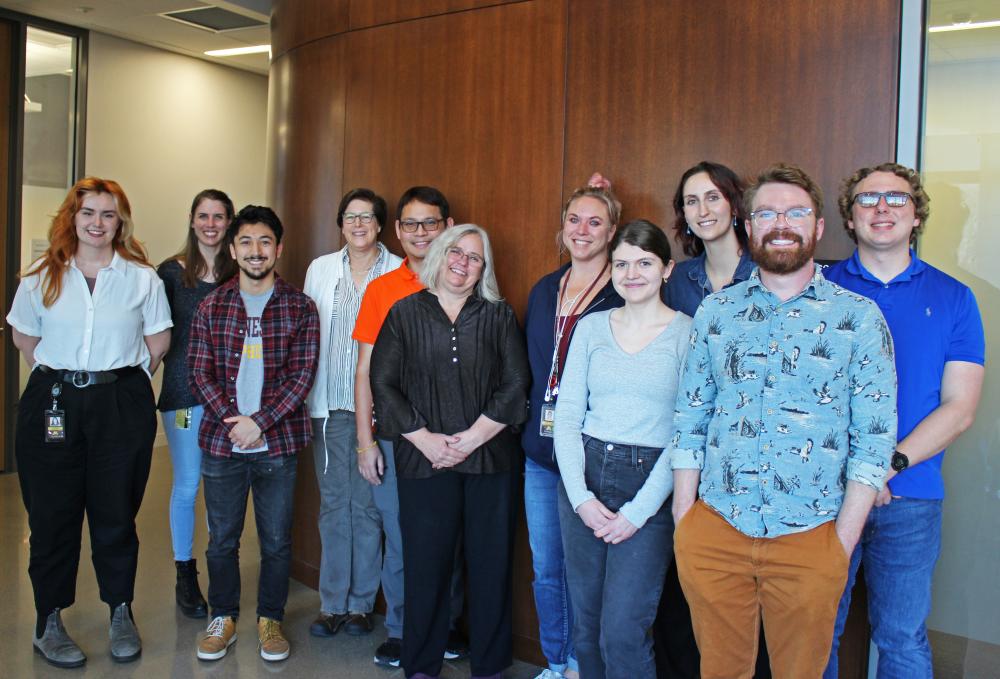Discovering novel treatments for HIV and Prion disease with the Skinner lab
February 14, 2024

VBS Professor Pamela Skinner and her laboratory team, Mary Pampusch (Research Project Specialist 3), Kelsie Becklin (Postdoctoral Associate), Pongthorn Pumtang-on (Postdoctoral Associate), Emily Sevcik (Postdoctoral Associate), Lili Thron (Research Assistant & MPAT Graduate Student), Zoe Quinn (Researcher 3), James Berg (Researcher 1), Ian Gorrell-Brown (Researcher 1), Max Cantor (Researcher 1), & Maddie Ellefson (Student Technician), investigate and develop novel treatments for Human immunodeficiency virus (HIV) and prion disease immuno-pathogenesis.
HIV is a virus that attacks the body’s immune system and if not treated, it can lead to AIDS (acquired immunodeficiency syndrome). Prion diseases or transmissible spongiform encephalopathies are a family of rare progressive neurodegenerative disorders that affect both humans and animals. They are distinguished by long incubation periods, characteristic spongiform changes associated with neuronal loss, and a failure to induce inflammatory response.
The Skinner Lab team graciously agreed to sit down to answer interview questions as a group to explain more about their individual roles in the laboratory and the lab mission.
Link to Lab website: https://skinnerlab-vetmed.umn.edu/
How did you get into your line of research?
Pam Skinner: When I was an undergraduate student, I did directed research with Dr. Michael Simmons and studied transposons. I loved it! While there I met staff scientists and trainees and it occurred to me that people can do research for a job (yes, I was that naive). That led me to the life sciences summer undergraduate research program where I worked with Dr. Leslie Schiff and studied reoviruses. At the end of the summer, I quit my job as a waitress and took a 50% pay reduction to become a full time technician with Leslie. I entered the field knowing that I would probably never be wealthy as a scientist, but knew that I would always have a job that I enjoyed. After working for Leslie for a while, I started coming up with research questions. The MD/PhD student in the lab was struggling with his project and I gave him ideas that helped him. It was then it occurred to me that I had what it takes to be a PhD student. I entered the Pathobiology program (now MICaB) and studied spinocerebellar ataxia with Dr. Harry Orr. I was a single mom, and after completion of my PhD needed to stay in MN. This required me to change fields of study. I took a postdoc position with Dr. Ashley Haase, and began studying HIV, which I continue to study now, over twenty years later.
What do you investigate and research?
Lili: Our lab has developed an immune cell therapy that targets and kills HIV-infected cells that hide out inside of a follicle within the lymph node. I am engineering a version of these cells with additional modifications that should help them to survive and persist longer. We intend to test the product that I make in HIV-infected humanized mice to see if it is safe and can successfully suppress HIV infection.
James: I investigate tissues from various organs around the body such as lymph nodes and organs of the central nervous system to determine the potential location and type of HIV-infected cells that produce virus.
Max: My duties often vary with the needs of the lab at the time. I am mostly involved in determining how well our therapeutic cells migrate, as well as how many copies of receptor proteins are expressed on the surface of our cells. Additionally, I am also involved in our project studying in vivo functionality of our therapeutic cells in humanized mice.
Maddie: I am trying to determine whether a specific receptor protein is down modulated in HIV-infected immune cells. I am looking at the number of cells located within infected lymph node tissue sections using fluorescence microscopy techniques.
Emily: We produce therapeutic cells to target and destroy HIV virus-infected cells. We test the cells in animal models of HIV including monkeys and humanized mice. I work with tissues from monkeys that are treated with therapeutic cells. I use fluorescent stains so that I can use a microscope to look within tissues to find the amount of therapeutic cells and virus-infected cells, and where the cells are located.
Mary: I have been responsible for development of the cell culture techniques that allow us to transduce T cells so that they express surface molecules which make them specific to HIV infected cells. My job also involves managing the projects, personnel and animal studies.
Pongthorn: We have developed HIV-specific immune cells to kill HIV-infected cells. I am responsible for the assessment of cell functionality in cell cultures and the humanized mouse models.
Kelsie: I study how we can use the immune system to target HIV infected cells in our central nervous system, the place where our brain and spinal cord reside. People living with HIV often get neurodegenerative disorders, meaning their nerves don’t work as well and this causes them to struggle to do daily tasks and to remember their loved ones. By modeling this in tissue culture dishes and animal models we can understand how to make the sick cells go away and hopefully make life better for people living with HIV.
Zoe: I assist in the production of cell therapies that target SIV infected cells in monkey HIV models. Additionally, I assess the persistence, functionality, and safety of the cell products.
How does your science help human kind/animals?
Pam: We investigate mechanisms mediating disease and then use this information to develop new treatments to help people and animals suffering from disease.
Lili: Our therapies could become the basis for a cure for HIV. We are working to fine-tune and improve these therapies so that they are as safe and efficacious as possible.
James: Understanding the location and types of cells infected by HIV helps provide essential insight into what is needed from the therapies being developed to effectively target infected cells and reduce the spread of the virus in hosts.
Max: Our science could determine if our cells are a safe and viable method of curing HIV. As a result, the virus may no longer be a burden to people living with HIV, who may be able to live normal lives without relying on expensive antiretroviral therapy.
Emily: Our science could potentially be used to cure HIV so people living with HIV do not have to take a regular regimen of antiretroviral drugs. Additionally, our science could potentially have applications towards other viral diseases or cancer.
Mary: HIV can be controlled with antiretroviral drugs but cannot be cured due to the reactivation of virus upon treatment cessation. We hope to develop therapies that will allow people to live a full life without the need for antiretroviral medications.
Pongthorn: Our immune cell therapies could be a potential approach to eradicate HIV-infected cells as the antiretroviral drugs are unable to to kill the infected cells.
Kelsie: I hope that through our work we can bring new therapies to clinic, which in and of itself will help humankind. I also hope that by studying diseases, such as HIV, that those struggling to cope with the lifelong health implications feel supported, heard, and hopeful for the future, just knowing that we are out here working for change.
Zoe: The work we do could potentially lead to a cure for HIV. While antiretroviral (ART) drugs have come a long way, they are unable to fully eliminate the virus in immune privileged sites. Our hope is to develop a therapy to target those areas and reduce the need for long term ART drug usage.
Are there any special accomplishments you would like to share (e.g. publications, patents, awards, collaborations?)
Pam: I am most proud of the over 80 trainees that have performed research in my lab and went on to successful careers in the field of science. I am also passionate about equity and inclusion and am proud to have been awarded the Mullen-Spector-Truax Women’s Leadership Award by the University of Minnesota’s Women’s Center and the Office for Equity and Diversity.
Lili: I recently received an award for an outstanding poster presentation at the U of M Department of Pharmacology’s annual retreat.
Mary: We are proud of providing the cover image for Plos Pathogens showing our CAR T cells interacting with a virally infected cell in the lymph node of a treated animal.
What are your long or short-term research goals?
Pam: My long term goal is to cure HIV.
Lili: Pass my written and oral preliminary exams!
James: To provide a better insight of the virus in the central nervous system.
Max: To find ways of producing more effective immunotherapies for HIV and to begin working on a research project in the Skinner lab as part of my Masters degree.
Maddie: To hone my current lab skills and gain new ones over the next couple of years before I go to grad school.
Mary: To understand the mechanisms limiting persistence of the CAR T cells in vivo.
Kelsie: I am really passionate about cell and gene therapy and believe that the next phase of human health will transition from chemical based therapeutics to the cell and gene therapy space. Being on the forefront of these advancements and aiding in societal understanding of these therapies are my passion. Along with developing the next generation of researchers through mentorship of younger scientists.
Pongthorn: To produce safe and effective immune cells that can kill HIV-infected cells for both preclinical and clinical trials.
(Group photo credit goes to Renee DeMars Dehn. Pictured from left to right: Zoe Quinn, Emily Sevcik, Max Cantor, Mary Pampusch, Pongthorn Pumtang-on, Pam Skinner, Kelsie Becklin, Maddie Ellefson, Lili Thron, Ian Gorrell-Brown, and James Berg.)


